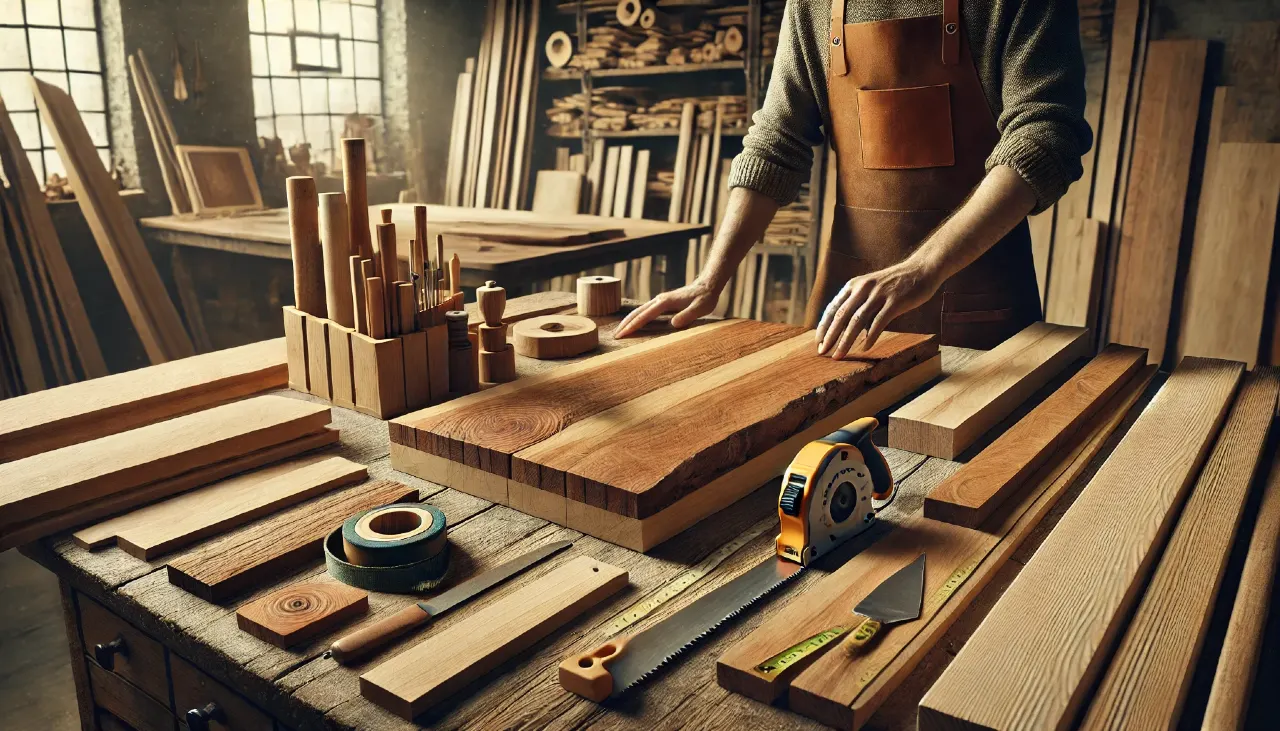When starting a furniture project, one of the most important decisions you’ll make is selecting the right wood. Whether you’re aiming for a rustic charm or a sleek modern finish, the type of wood you use plays a key role in the look, durability, and cost of your furniture. Knowing the different types of wood for furniture making can help you create stunning pieces that are both functional and long-lasting.
Types of Wood for Furniture Making
Furniture can be made from many different wood types, but they generally fall into two categories: hardwood and softwood.
Hardwood vs. Softwood for Furniture
Hardwoods are derived from deciduous trees, like oak and maple, and are known for their strength and durability. Softwoods, on the other hand, come from coniferous trees such as pine and cedar. Each has its own benefits:
- Hardwoods: More durable, better for high-traffic areas, and often have a rich grain. Common examples include oak, maple, and walnut.
- Softwoods: More affordable, easier to work with, and often used in DIY furniture projects. Common types include pine and spruce.
Understanding the distinction between hardwood and softwood helps in making an informed decision for your furniture project.
Best Wood for Furniture
Choosing the best wood for furniture depends on factors like the piece’s intended use, aesthetic preferences, and budget. Here’s a breakdown of some popular choices:
Oak vs. Pine Furniture
Oak and pine are two of the most widely used woods in furniture making, but they differ significantly in appearance and functionality:
- Oak furniture: Oak is a hardwood known for its strength and pronounced grain. It is ideal for heavy-use furniture like tables and bed frames. Oak also ages well, making it a great choice for traditional designs.
- Pine furniture: Pine, a softwood, is much lighter and easier to work with. It’s also more affordable, making it popular for budget-friendly furniture. However, pine is more prone to dents and scratches.
Deciding between oak vs. pine often comes down to your budget and the durability needed for the piece.
Most Durable Wood for Furniture
If you’re looking for the most durable wood for your project, hardwoods like mahogany, cherry, and teak are excellent choices. These woods offer longevity and resistance to wear, making them perfect for sturdy furniture like dining tables and dressers. Teak is especially known for its wood durability, even in outdoor settings, due to its natural oils that resist rot and decay.
Affordable Wood for Furniture
For those on a budget, several types of affordable wood for furniture still provide good quality. Some of the best budget-friendly woods include:
- Pine: Widely available and inexpensive, ideal for beginner furniture makers.
- Poplar: A softwood with a smooth grain, easy to paint and finish.
- Birch: A light hardwood that’s less expensive than oak or maple but still durable.
These woods are perfect for DIY furniture projects where cost is a concern but quality cannot be compromised.
Sustainable Wood for Furniture Projects
If you’re interested in minimizing your environmental impact, choosing sustainable wood for furniture projects is crucial. Eco-friendly wood options include:
- Bamboo: Technically a grass, bamboo grows rapidly and is highly sustainable. It’s also strong and visually appealing.
- Reclaimed wood: Using recycled wood from old structures not only saves trees but also provides a unique, weathered look that can’t be replicated.
- Certified woods: Look for woods certified by the Forest Stewardship Council (FSC) to ensure that they are sourced responsibly.
Incorporating sustainable wood in your furniture projects is an excellent way to create beautiful pieces while protecting the environment.
Best Wood for DIY Furniture
For DIY furniture makers, selecting a wood that’s easy to work with is essential. Softwoods like pine and spruce are often chosen for their affordability and ease of cutting, sanding, and staining. Poplar and maple are also excellent choices for DIYers due to their versatility and smooth grain, making them easy to finish and paint.
Wood Grain for Furniture Projects
When choosing wood, pay attention to the wood grain. The grain affects not only the visual appearance of your furniture but also its strength. For example, straight-grain wood is typically stronger and more durable, while curly or irregular grains can add an interesting visual texture to your project.
Popular Woods for Furniture Building
Some of the most popular woods for furniture building include:
- Oak: Strong and durable, with a distinctive grain.
- Maple: Smooth grain and very hard, great for furniture that needs to resist wear.
- Walnut: Dark, rich wood perfect for high-end, elegant pieces.
These solid wood furniture options provide various benefits and aesthetics depending on the type of furniture you’re creating.
Wood Finishes for Furniture
Once you’ve selected your wood, it’s important to choose the right wood finish to protect and enhance its beauty. Popular finishes include:
- Stains: Highlight the natural grain while adding color.
- Varnishes: Provide a hard, protective coat that’s water-resistant.
- Oils: Like linseed or tung oil, these finishes penetrate the wood, bringing out the natural beauty while offering minimal protection.
Choosing the right wood finishes for furniture helps ensure that your piece lasts for years to come.
Softwood Furniture: Pros and Cons
While softwood furniture is generally more affordable and easier to work with, there are some pros and cons to consider:
Pros:
- Cost-effective: Softwoods like pine and fir are significantly cheaper than most hardwoods.
- Easy to work with: Softwoods are lighter and easier to cut, making them great for DIY projects.
- Availability: Readily available at most lumber yards and home improvement stores.
Cons:
- Less durable: More prone to dents, scratches, and general wear.
- Susceptible to moisture: Softwoods can warp or swell when exposed to humidity.
Softwoods are ideal for projects where cost and ease of use are priorities, but they may not hold up as well in high-traffic areas.
Hardwood Furniture Benefits
On the other hand, hardwood offers significant advantages:
- Durability: Hardwoods are incredibly strong and resistant to wear, making them ideal for long-lasting furniture.
- Aesthetic appeal: The rich grain and color of hardwoods like walnut and cherry provide a more luxurious appearance.
- Value: Furniture made from hardwoods tends to hold its value better over time due to its durability and timeless look.
These hardwood furniture benefits make it the best option for heirloom-quality pieces or furniture that needs to withstand daily use.
Comparing Wood for Furniture Projects
When comparing wood for furniture projects, consider factors like:
- Durability: Hardwoods like oak are ideal for heavy-use furniture.
- Cost: Softwoods like pine offer a budget-friendly option but may lack the durability of hardwoods.
- Workability: Choose woods that match your skill level; softwoods are easier for beginners, while hardwoods may require more tools and experience.
Wood Durability for Furniture
One of the key considerations when selecting wood for your project is its durability. Woods like mahogany, maple, and cherry are known for their wood strength, making them excellent choices for high-use furniture.
Best Wood for Sturdy Furniture
For the sturdiest furniture, choose hardwoods like oak or maple. These woods are incredibly durable and can withstand years of use without showing significant wear.
Eco-Friendly Wood for Furniture
If sustainability is a priority, consider eco-friendly wood options such as:
- Reclaimed wood: Offers a unique, aged appearance while reducing waste.
- Bamboo: Fast-growing and sustainable, bamboo is strong and versatile.
- FSC-certified woods: Ensure that your wood comes from responsibly managed forests.
Incorporating sustainable wood into your furniture projects is a great way to create eco-conscious designs.
Exotic Wood for Custom Furniture
For those looking to make a statement, exotic woods offer unique grains, colors, and textures. Woods like zebrawood, ebony, and rosewood are highly sought after for custom furniture due to their striking appearance. However, they can be more expensive and harder to source.
Woodworking Tips for Beginners
For beginners, here are a few essential woodworking tips to ensure a successful project:
- Start with softwoods: They are easier to work with and more forgiving for mistakes.
- Invest in quality tools: A good saw, measuring tape, and sanding tools will make your project much easier.
- Measure twice, cut once: Accurate measurements are key to a successful build.
These woodworking tips for furniture making will help guide you through your first few projects.
Choosing the Best Wood for Your Furniture Project
Selecting the right wood is essential to creating beautiful and durable furniture. Whether you opt for the strength and elegance of hardwoods or the affordability and workability of softwoods, understanding the furniture grade wood types available will help you achieve professional results. By considering factors like wood grain, durability, cost, and sustainability, you can choose the perfect wood to match both your style and needs.




